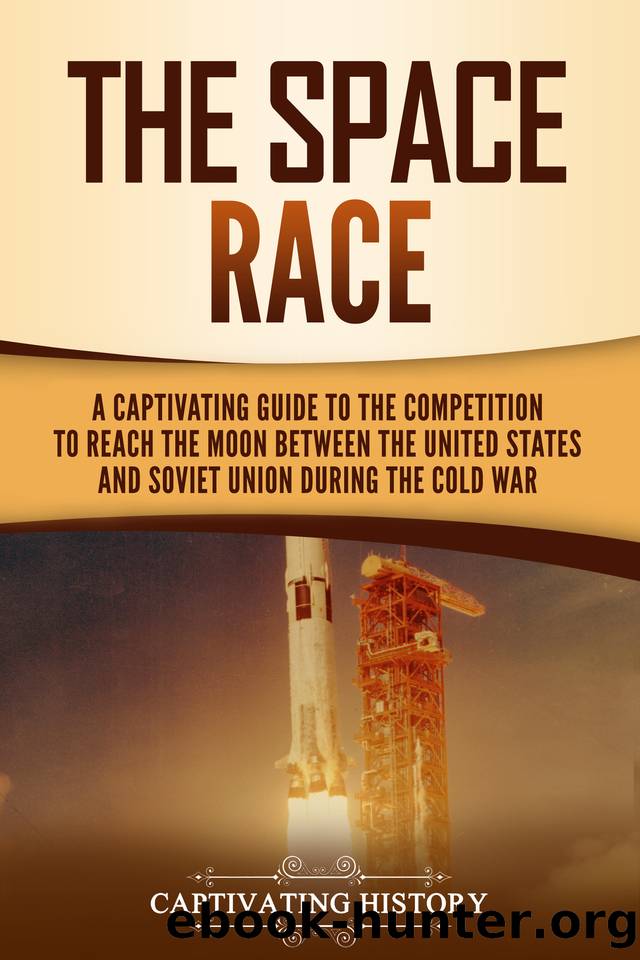The Space Race: A Captivating Guide to the Cold War Competition Between the United States and Soviet Union to Reach the Moon by History Captivating

Author:History, Captivating [History, Captivating]
Language: eng
Format: epub
Published: 2020-09-28T00:00:00+00:00
Chapter 8 â The First Men in Space
After spending several years testing in space and learning as much as possible with scientific instruments and short trips using animals, both sides were getting closer to achieve one of the greatest accomplishments in human historyâthe successful launch of a person intoâand back fromâspace. Both superpowers were eager to be the first, though they went about it in different ways.
The USSR would just barely beat the US to this milestone, with both hitting this goal in 1961.
Yuri Gagarin and a Question of What Counted as a Success
As its technology continued to advance, the Soviet Union started to review potential candidates for the first person in space. The Soviets had narrowed down their options to twenty potential candidates, whom they called cosmonauts. Each of the candidates was required to complete a series of tests to determine their ability to withstand the potential risks. The tests were once described by Cathleen Lewis: âThey were performing enormous feats of physical training ... They wanted to test the limits of their pilots.â The Soviets had learned from the other missions with animals that it was nearly impossible to guess what would happen once the launch began.
Two men stood out from the other candidates. Twenty-seven-year-old Yuri Gagarin was chosen to be the first Soviet (and, they hoped, person) in space, and Gherman Titov would be his backup. Reportedly, Gagarin had more humble origins, and this was desirable considering what they hoped he would become if the mission was successful. Titov had been raised in a family that was considered middle-class, while Gagarinâs parents had been closer to blue-collar workers. This meant he had to overcome more to gain his place, which better represented what the Soviets wanted to portrayâa person overcoming much longer odds to become a national hero. It would help inspire people across the Soviet Union to strive for more by working harder.
His humble background could have been a reason, but many people say it was more likely Gagarinâs performance during the tests that ultimately led to his being chosen. Unaware that the US had been tracking its own countdown to launch someone into space, the Soviets pushed forward with its own plans in secret. Despite not knowing the American plans, the Soviets were aware that the US was making advances, and they were worried that they would lose the edge they had established through the first round of milestones. To ensure they were the first, the Soviets continued to push for a launch as soon as possible.
Following the rigorous selection process and testing, the USSR began to prepare for the launch, setting up Vostok 1 on the launchpad. On April 12, 1961, Gagarin prepared himself at the top of a thirty-meter-high booster on the launch site in Kazakhstan (the modern-day Baikonur Cosmodrome). The cosmonaut was five-foot-two-inches tall, which made him a much better choice for the small quarters. Still, it couldnât have been terribly comfortable, as the rocket began to shake before departing from Earth. At 9:07 a.
Download
This site does not store any files on its server. We only index and link to content provided by other sites. Please contact the content providers to delete copyright contents if any and email us, we'll remove relevant links or contents immediately.
| Africa | Americas |
| Arctic & Antarctica | Asia |
| Australia & Oceania | Europe |
| Middle East | Russia |
| United States | World |
| Ancient Civilizations | Military |
| Historical Study & Educational Resources |
Magic and Divination in Early Islam by Emilie Savage-Smith;(1500)
Ambition and Desire: The Dangerous Life of Josephine Bonaparte by Kate Williams(1344)
Bohemians, Bootleggers, Flappers, and Swells: The Best of Early Vanity Fair by Bohemians Bootleggers Flappers & Swells- The Best of Early Vanity Fair (epub)(1343)
Papillon by Henry Charrière(1310)
Twelve Caesars by Mary Beard(1256)
Operation Vengeance: The Astonishing Aerial Ambush That Changed World War II by Dan Hampton(1135)
What Really Happened: The Death of Hitler by Robert J. Hutchinson(1128)
London in the Twentieth Century by Jerry White(1112)
Time of the Magicians by Wolfram Eilenberger(1088)
The Japanese by Christopher Harding(1086)
Twilight of the Gods by Ian W. Toll(1084)
Lenin: A Biography by Robert Service(1045)
The Devil You Know by Charles M. Blow(985)
A Social History of the Media by Peter Burke & Peter Burke(936)
Freemasons for Dummies by Hodapp Christopher;(922)
Napolean Hill Collection by Napoleon Hill(902)
Henry III by David Carpenter;(891)
The Churchill Complex by Ian Buruma(881)
The Rise and Triumph of the Modern Self by Unknown(879)
